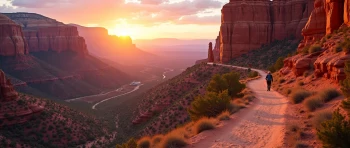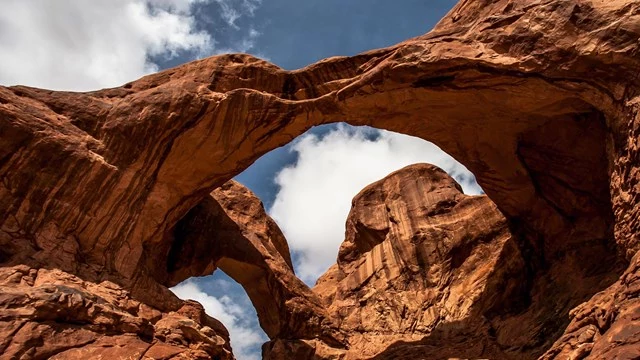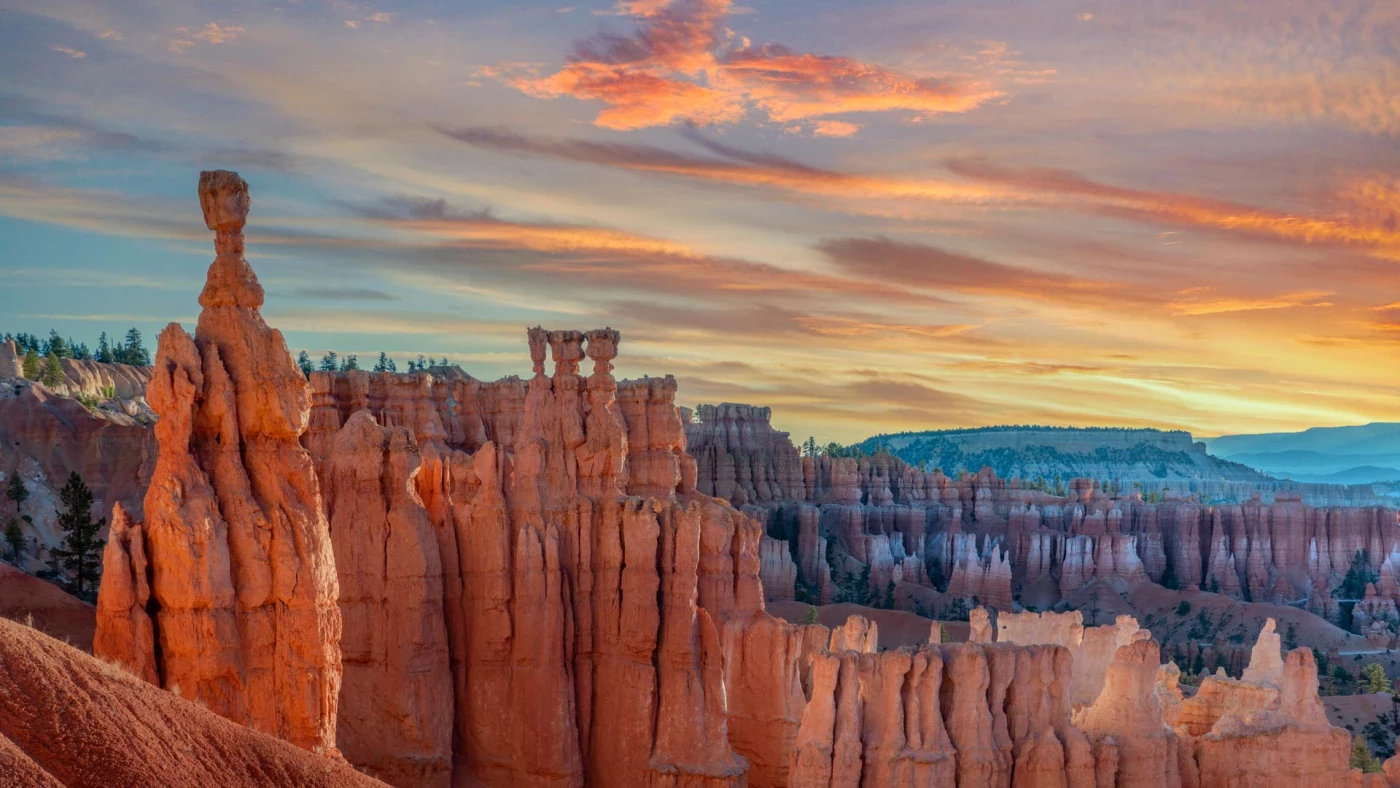Utah stands as a crown jewel in America's national park system, boasting the "Mighty Five" national parks and numerous other protected areas that showcase some of the most spectacular landscapes on earth. From towering red rock formations to otherworldly hoodoos and expansive canyon systems, Utah's parks offer visitors unparalleled natural beauty and outdoor adventure opportunities. This comprehensive guide will help you plan the perfect visit to Utah's national parks in 2025.
Utah's "Mighty Five" National Parks
Zion National Park
Best Time to Visit: Late spring (April-May) and fall (September-October) offer pleasant temperatures and fewer crowds. Winter provides a unique, peaceful experience with occasional snow dusting the red rocks.
What's New for 2025:
- The timed entry reservation system continues but with expanded capacity
- Completion of the South Entrance visitor center renovation
- Additional shuttle buses to reduce wait times
- New accessible trails in the main canyon area
Must-See Attractions:
- Angels Landing: This famous knife-edge trail with chain assists leads to breathtaking views (permit required)
- The Narrows: Wade through the Virgin River between towering canyon walls
- Emerald Pools: A relatively easy hike to serene pools and waterfalls
- Kolob Canyons: Less-visited section offering stunning scenery and solitude
- Watchman Trail: Perfect for sunset views of the main canyon
Hidden Gems:
- Observation Point via East Mesa Trail (bypassing the closed main trail)
- Cable Mountain Trail for views without the crowds of Angels Landing
- Pa'rus Trail for wildlife viewing and photography, especially at dawn and dusk
Practical Tips:
- Make shuttle and hiking permit reservations months in advance
- Stay in Springdale for convenient park access
- Visit popular trails before 8am or after 4pm to avoid crowds
- Consider the east side for less crowded accommodation options
Arches National Park
Best Time to Visit: March-May and September-October provide ideal temperatures. Summer brings intense heat (often exceeding 100°F), while winter offers solitude with occasional snow.
What's New for 2025:
- Timed entry system in place during peak season (March-October)
- Newly completed Devils Garden Trail improvements
- Extended ranger programs focusing on night sky preservation
- New viewpoints along the main park road
Must-See Attractions:
- Delicate Arch: Utah's iconic symbol requires a moderate 3-mile round-trip hike
- Landscape Arch: One of the world's longest natural stone arches
- Double Arch: Easily accessible and impressive dual arch formation
- Windows Section: High concentration of arches with minimal hiking required
- Devils Garden: Extended trail featuring eight impressive arches
Hidden Gems:
- Tower Arch in the remote Klondike Bluffs area
- Broken Arch and Sand Dune Arch for peaceful, less-visited experiences
- Fiery Furnace (ranger-led or permitted hikes only)
Practical Tips:
- Reserve timed entry permits up to three months in advance
- Visit popular arches at sunrise for best photography and fewer crowds
- Carry ample water (1 gallon per person per day recommended)
- Stay in Moab, which offers numerous accommodation and dining options
Bryce Canyon National Park
Best Time to Visit: Summer offers pleasant temperatures due to the park's high elevation. Spring and fall provide fewer crowds and comfortable conditions. Winter transforms the red rock hoodoos with snow, creating a magical landscape.
What's New for 2025:
- Completion of the new stargazing amphitheater
- Expanded winter programming
- New accessible viewpoints along the rim
- Enhanced shuttle service during peak months
Must-See Attractions:
- Bryce Amphitheater: The park's iconic concentration of hoodoos
- Navajo Loop Trail: Descend among the hoodoos through Wall Street and Thor's Hammer
- Queens Garden Trail: Often combined with Navajo Loop for the best experience
- Inspiration Point: Panoramic views of the main amphitheater
- Bryce Point: Spectacular sunrise viewing location
Hidden Gems:
- Fairyland Loop for a longer, less-crowded experience among the hoodoos
- Mossy Cave Trail on the park's north side
- Rainbow Point and Yovimpa Point at the end of the scenic drive
- Astronomy programs at one of the darkest night sky locations in the country
Practical Tips:
- The park sits at 8,000-9,000 feet elevation; allow time to acclimate
- Rim Trail connects most viewpoints and offers flexible hiking options
- Consider staying in Tropic or Bryce Canyon City for closest access
- Pack for variable weather, as temperatures can fluctuate dramatically
Capitol Reef National Park
Best Time to Visit: Spring and fall provide ideal temperatures and blooming fruit orchards (spring) or fall colors and harvest (fall). Summer is warm but manageable, and winter offers solitude with occasional snow.
What's New for 2025:
- New backcountry trails in the Cathedral Valley district
- Expanded fruit orchard harvesting opportunities
- New exhibits at the Gifford Homestead
- Additional ranger-led geology programs
Must-See Attractions:
- Scenic Drive: 8-mile paved road showcasing park highlights
- Fruita Historic District: Historic Mormon settlement with orchards and buildings
- Hickman Bridge: Moderate 2-mile round-trip hike to a natural bridge
- Cassidy Arch: Stunning arch named after Butch Cassidy
- Capitol Gorge: Easy walk through a narrow canyon with pioneer inscriptions
Hidden Gems:
- Cathedral Valley's monolithic rock formations (high-clearance vehicle required)
- Upper Muley Twist Canyon for exceptional views and arches
- Picking seasonal fruit in the historic orchards (when available)
- Waterpocket Fold viewpoints along Strike Valley
Practical Tips:
- The park is divided into distinct districts; plan accordingly
- Gifford Homestead serves fresh-baked pies that shouldn't be missed
- Cell service is very limited; download maps in advance
- Torrey and Boulder offer the closest accommodations
Canyonlands National Park
Best Time to Visit: Spring and fall offer the most pleasant temperatures. Summer brings intense heat, particularly in the lower elevations, while winter provides solitude but potential access issues.
What's New for 2025:
- Improved overlooks at Island in the Sky district
- New backcountry trails in The Needles district
- Enhanced visitor center exhibits focusing on water conservation
- Expanded dark sky programming
Must-See Attractions:
- Island in the Sky: Mesa with panoramic vistas, including Mesa Arch and Grand View Point
- The Needles: Colorful spires of Cedar Mesa sandstone with extensive hiking options
- The Maze: Remote, rugged district for experienced backcountry adventurers
- Colorado and Green Rivers: Defining waterways that carved the canyons
- Shafer Trail: Dramatic backcountry road (4WD required)
Hidden Gems:
- Druid Arch in The Needles district
- Chesler Park Loop for some of the park's most dramatic scenery
- Confluence Overlook to see the merging of the Colorado and Green Rivers
- Murphy Loop for a challenging hike with fewer crowds
Practical Tips:
- The park's districts are not connected by roads within the park
- High-clearance 4WD vehicles are needed for many backcountry roads
- Cell service is non-existent in most areas
- Moab provides the best access to Island in the Sky, while Monticello is closer to The Needles
Lesser-Known Utah Parks and Monuments
Grand Staircase-Escalante National Monument
Best Time to Visit: Spring and fall offer ideal hiking weather. Summer can be extremely hot, while winter brings solitude but potential road access issues.
What's New for 2025:
- New visitor center in Escalante
- Expanded trail system in the Kaiparowits Plateau
- Additional guided hiking programs
- Improved backcountry road signage
Must-See Attractions:
- Lower Calf Creek Falls: 6-mile round-trip hike to a 126-foot waterfall
- Hole-in-the-Rock Road: Access to slot canyons and unique formations
- Escalante River: Riparian corridor with numerous hiking opportunities
- Scenic Byway 12: One of America's most scenic drives
- Kodachrome Basin State Park: Adjacent park with colorful spires
Hidden Gems:
- Zebra and Tunnel slot canyons (permits required)
- Cosmic Ashtray formation (difficult access)
- Grosvenor Arch double arch formation
- Devil's Garden mushroom rock formations
Practical Tips:
- Many roads are impassable when wet; check conditions before venturing out
- High-clearance vehicles recommended for most dirt roads
- Cell service is extremely limited; bring physical maps
- Escalante and Boulder offer limited but quality accommodation options
Bears Ears National Monument
Best Time to Visit: Spring and fall provide the most pleasant temperatures and conditions. Summer can be hot, while winter brings potential snow and access issues.
What's New for 2025:
- Enhanced protection of archaeological sites
- New interpretive signage developed with tribal partners
- Additional ranger presence in key areas
- Improved trailheads and access points
Must-See Attractions:
- House on Fire Ruin: Iconic archaeological site with unique lighting effect
- Butler Wash Ruins: Accessible Ancestral Puebloan cliff dwellings
- Cedar Mesa: Concentration of archaeological sites and natural beauty
- Valley of the Gods: Monument Valley-like formations with fewer crowds
- Natural Bridges National Monument: Three impressive natural bridges
Hidden Gems:
- Moon House Ruin (limited permits available)
- Bullet Canyon petroglyphs and ruins
- Bears Ears Buttes traditional cultural landscape
- Mule Canyon ruins
Practical Tips:
- Cultural sensitivity is essential; respect archaeological sites
- Many areas require high-clearance 4WD vehicles
- Permits required for many backcountry areas
- Blanding and Bluff offer the closest accommodations
- Cell service is virtually non-existent
Cedar Breaks National Monument
Best Time to Visit: Summer and early fall, as the monument sits at over 10,000 feet elevation and is often snow-covered until June.
What's New for 2025:
- New stargazing platforms
- Enhanced wildflower festivals in July
- Improved winter access for snowshoeing and cross-country skiing
- Expanded ranger programs
Must-See Attractions:
- Amphitheater Overlooks: Spectacular views of colorful eroded formations
- Alpine Pond Trail: Gentle loop through meadows and forest
- Spectra Point Trail: Moderately challenging hike with bristlecone pines
- Wildflower displays: Peak bloom typically occurs in July
- Dark sky programs: Some of the darkest skies in the country
Hidden Gems:
- Rattlesnake Creek Trail for a challenging descent into the amphitheater
- Twisted Forest Trail for ancient bristlecone pines
- Early morning wildlife viewing opportunities
- Winter full moon snowshoe hikes
Practical Tips:
- The high elevation means cooler temperatures and possible altitude effects
- Main park road typically closed November through May
- Brian Head resort town provides closest accommodations
- Spectacular alternative when Bryce Canyon is crowded
Dinosaur National Monument
Best Time to Visit: Spring and fall offer pleasant temperatures. Summer can be hot but manageable, while winter brings limited access to some areas.
What's New for 2025:
- Renovated Quarry Exhibit Hall
- New paleontology programs
- Expanded river rafting permits
- Enhanced petroglyph viewing platforms
Must-See Attractions:
- Quarry Exhibit Hall: Indoor wall containing approximately 1,500 dinosaur fossils
- Green and Yampa Rivers: Scenic waterways with rafting opportunities
- Petroglyphs: Ancient rock art at multiple locations
- Harpers Corner Drive: Scenic drive with dramatic overlooks
- Split Mountain Gorge: Impressive canyon with boat launch
Hidden Gems:
- Jones Hole Trail with petroglyphs and a creek
- Echo Park's confluence of rivers and impressive rock formations
- Ruple Point Trail for panoramic views
- Desert Voices Trail for geology and nature interpretation
Practical Tips:
- The monument spans two states (Utah and Colorado)
- The Utah side (Quarry) and Colorado side (Canyon) offer different experiences
- High-clearance vehicles recommended for many backcountry roads
- Vernal, Utah and Dinosaur, Colorado offer the closest accommodations
Planning Your Multi-Park Utah Adventure
Sample Itineraries
1. The Mighty Five in 10 Days (Ambitious)
- Days 1-2: Zion National Park
- Day 3: Bryce Canyon National Park
- Days 4-5: Capitol Reef National Park
- Days 6-7: Arches National Park
- Days 8-9: Canyonlands National Park
- Day 10: Travel day
2. Southern Utah Parks in 7 Days
- Days 1-2: Zion National Park
- Day 3: Bryce Canyon National Park
- Day 4: Grand Staircase-Escalante National Monument
- Day 5: Capitol Reef National Park
- Days 6-7: Return to Zion or Las Vegas
3. Moab Area Parks in 5 Days
- Days 1-2: Arches National Park
- Day 3: Island in the Sky (Canyonlands)
- Day 4: The Needles (Canyonlands)
- Day 5: Dead Horse Point State Park and return
4. Native American Heritage Tour (7 Days)
- Days 1-2: Bears Ears National Monument
- Day 3: Hovenweep National Monument
- Day 4: Monument Valley Tribal Park
- Days 5-6: Canyon de Chelly National Monument (Arizona)
- Day 7: Return via Four Corners Monument
Transportation Tips
- Airports: Salt Lake City offers the most flight options, while smaller airports in St. George, Cedar City, and Moab provide more localized access
- Car Rental: Essential for exploring Utah's parks; consider 4WD for accessing remote areas
- Park Shuttles: Zion requires shuttle use for much of the year; Bryce offers optional shuttles
- Driving Times: Allow ample time between parks (Zion to Bryce: 2 hours; Bryce to Capitol Reef: 2.5 hours; Capitol Reef to Moab: 3 hours)
Accommodation Strategies
- Book Early: Reserve accommodations 6-12 months in advance, especially for in-park lodging
- Gateway Towns: Springdale (Zion), Torrey (Capitol Reef), Moab (Arches/Canyonlands), Tropic/Bryce Canyon City (Bryce)
- Alternative Bases: Kanab and St. George can serve as bases for southern parks
- Camping: Reserve developed campgrounds early or explore dispersed camping on BLM land
- Unique Options: Consider yurts, tiny homes, and glamping experiences near several parks
Park Passes and Reservations
- America the Beautiful Pass: $80 annual pass covers entry to all national parks and federal recreation sites
- Timed Entry Reservations: Required for Arches during peak season and Angels Landing at Zion (reserve early)
- Backcountry Permits: Required for overnight backpacking and certain day hikes (The Subway, Fiery Furnace)
- Commercial Tours: Consider for specialized experiences like photography, canyoneering, or cultural tours
Conservation and Responsible Visitation
Leave No Trace Principles
- Plan ahead and prepare
- Travel and camp on durable surfaces
- Dispose of waste properly
- Leave what you find
- Minimize campfire impacts
- Respect wildlife
- Be considerate of other visitors
Water Conservation
- Utah's parks exist in a desert environment facing increased drought
- Bring reusable water bottles and fill at designated stations
- Keep showers brief at campgrounds and accommodations
- Report water leaks to park staff
Cultural Respect
- Archaeological sites are fragile and irreplaceable
- Never touch rock art or structures
- Stay on designated trails near cultural sites
- Learn about Indigenous peoples whose ancestral lands you're visiting
Wildlife Protection
- Maintain safe distances from all wildlife
- Never feed animals, which creates dangerous dependencies
- Drive carefully, especially at dawn and dusk
- Keep pets leashed where allowed (many trails prohibit pets)
I'll continue with the rest of the content from where the document was cut off.
Seasonal Considerations
Spring (March-May)
- Wildflowers blooming
- Pleasant temperatures
- Potential for flash floods
- Rivers running high
- Busy during spring break periods
Summer (June-August)
- Very hot temperatures, especially at lower elevations
- Afternoon thunderstorms common
- Peak tourist season with larger crowds
- Extended daylight hours for activities
- Best time for high-elevation areas like Cedar Breaks
Fall (September-November)
- Mild, stable weather conditions
- Smaller crowds after Labor Day
- Fall colors in higher elevations (late September to mid-October)
- Many consider this the optimal season
- Shorter days require careful planning
Winter (December-February)
- Snow possible at all parks, common at higher elevations
- Dramatically reduced crowds
- Limited services and potential road closures
- Stunning snow-covered landscapes
- Ideal for photography and solitude
Special Experiences and Activities
Stargazing Opportunities
- Utah parks offer some of the world's darkest skies
- Bryce Canyon and Natural Bridges are International Dark Sky Parks
- Ranger-led astronomy programs available at most parks
- Best viewing during new moon periods
- Consider specialized night photography tours
Photography Tips
- Golden hour lighting (early morning/late afternoon) creates dramatic landscapes
- Tripods essential for low-light and night photography
- Consider polarizing filters for enhanced sky contrast
- Popular spots require early arrival for optimal positioning
- Weather changes can create unique atmospheric conditions
Outdoor Adventures
- Canyoneering in Zion and Grand Staircase-Escalante
- Rock climbing in Indian Creek (Bears Ears)
- Mountain biking on adjacent BLM lands
- Whitewater rafting on Green and Colorado Rivers
- Horseback riding in Bryce Canyon and Capitol Reef
Family-Friendly Activities
- Junior Ranger programs at all national parks
- Short, accessible trails suitable for various ages
- Ranger-led educational programs
- Stargazing and wildlife watching
- Harvest fruit in Capitol Reef's orchards (seasonal)
What to Pack
Essential Gear
- Hiking boots with good ankle support
- Layered clothing for variable temperatures
- Rain jacket and sun protection
- Headlamp or flashlight for night activities
- First aid kit with blister treatment
Water and Hydration
- Hydration packs or multiple water bottles
- Electrolyte supplements
- Water filtration system for backcountry use
- Container for carrying water to remote sites
Navigation Tools
- Physical maps (digital versions may not work without service)
- GPS device with downloaded maps
- Compass and basic navigation knowledge
- Park brochures with trail information
Safety Items
- Emergency shelter
- Whistle and signaling mirror
- Basic survival kit
- Detailed itinerary left with someone not in your group
Technology and Connectivity
Cell Service
- Extremely limited or non-existent within most parks
- Best reception typically in visitor centers and gateway towns
- Download offline maps and information before arrival
- Consider satellite communication devices for remote areas
Apps and Resources
- National Park Service official apps
- AllTrails or Gaia GPS for trail information
- Stargazing apps for night sky identification
- Weather alerts and forecast apps
Photography Equipment
- Consider lens selection based on landscapes (wide-angle essential)
- Extra batteries (cold temperatures reduce battery life)
- Memory cards with adequate storage
- Camera protection from dust and sand
Power Solutions
- Solar chargers for extended backcountry trips
- Power banks for device charging
- Car chargers for between-park drives
- Battery conservation strategies
Final Tips for an Unforgettable Utah Parks Experience
- Allow more time than you think you'll need for each park
- Build flexibility into your itinerary for unexpected discoveries
- Rise early to avoid crowds and capture the best light
- Consider shoulder seasons for optimal experience
- Connect with local experts and rangers for insider knowledge
- Respect the fragile desert environment at all times
- Take time to simply sit and absorb the magnificent landscapes
- Look beyond the iconic views to discover personal connections
- Keep a journal or photo log to document your experiences
- Consider guided experiences for specialized knowledge or activities
Utah's national parks offer some of the most extraordinary landscapes on the planet. Whether you're standing at the edge of a towering canyon, walking among ancient hoodoos, or gazing at a natural arch framing the blue sky, these parks provide transformative experiences that connect visitors to the power and beauty of the natural world. With proper planning and a spirit of adventure, your 2025 Utah parks journey will create memories to last a lifetime.










